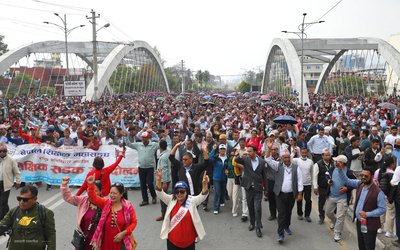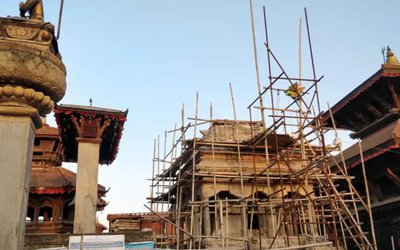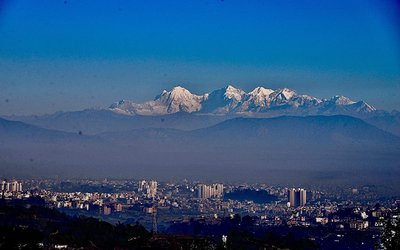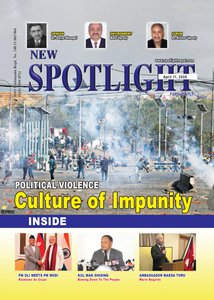There is a persistent Nepali belief that major political upheavals happen every ten years. With the Bickram calendar 2007 (Feb 1951) downfall of the Rana Regime, the first attempt to plant a Westminster-on-the-Bagmati failed and was replaced by the Panchayat in 2017. Ten years later its architect King Mahendra suddenly died of a heart attack even as he was working on making the system more democratic. His successor, King Birendra at first tried to retain the autocratic nature of the Panchayat in 2032 but as the tenth year of his reign loomed, by 2036 he was forced to declare Nepal’s first national referendum in which almost half his loyal subjects rejected even a reformed Panchayat while slightly more than half wanted serious democratic reforms in the system.
Hardline Panchayat barons, flush with procedural victory, pushed the system to an even harder stance in their mistaken belief that they had ‘won’ the referendum (much like the Kangress and EhMaLeys today believe that they received an overwhelming majority in the second CA2 elections to do as they like). However, by 2047, the Panchayat had to be abandoned completely and replaced by a second attempt at a Westminster model which, in the ten following years, saw kleptocracy and public revulsion flourish that fueled the Maoist insurgency. The decade, however, culminated in the Royal Massacre that continues to shake the foundations of Nepali state.
This year is the tenth since the November 2005 AD colour-coded “Rhododendron Revolution”; and its main architectural blueprint – the 12-point Delhi Deal among politically unlikely bedfellows – has collapsed and brought Nepali politics to a Nihilistic dead end. These last ten years have seen a long series of multi-point deals and equally multiple broken promises between these players. Meanwhile, the hopes of the voters have been dashed and Nepal stands at the edge of a cliff: the promised land of political stability seems to be receding like a mirage and its citizens fear they are staring at a possible abyss of tribal warfare that could replicate the fate of other colour-coded regime changes – from Libya to Afghanistan and Ukraine to Syria, with Thailand like Nepal barely above water.
“What next?” is the uncertain question on every thinking Nepali’s mind which may be better speculated upon by astrologers. The reflective public on the other hand has to answer another more pertinent question: giddy with buoyed up hopes of change into a ‘New Nepal’ ten years ago, why did we end up in this nightmare world of a ‘New Nepal’ alright but a horribly dysfunctional one at that, much worse than the one we threw out? We have to collectively ask and find that answer if this country is not to lose another decade without meaningful development and another young generation to nihilism and outmigration.
To begin this exploratory task, let us reflect backwards from today’s news headlines to yesterday’s events in the search for causes and culprits. End February saw a ‘show of force’ in the streets of Kathmandu by the Cash Maoists and its Madheshi alliance. Both are trapped within their impractical demand – in a country as mixed up ethnically as this one – of ethnic federalism. While the East Tarai Yadavites cannot even get the largest Tarai ethnic group, the Tharus, to agree to their separate Madhesh agenda, the Cashists present an even sorrier figure of a Marxist party ‘giving up on class and advocating caste’!
The people were largely absent or amused bystanders and the participation was mainly by conscripted corvee cadres (which would also have been the case if the Kangress or EhMaLeys had tried putting up such a show as well). It has to be interpreted as mainly an interneciene battle between the children of the now collapsed 12-point Delhi Deal. This minority is clamouring for an impossibly ephemeral ‘consensus’ this late in the game that was done away with immediately after the first CA1 elections in 2008. It was discarded to allow Prachanda and the EhMaLeys to form a majoritarian government after the hopes of both Girija Koirala and Prachanda to become Nepal’s first president were mercilessly dashed and the 12-point Delhi Deal’s consensus evaporated. Why should the current Kangressi lot now agree to it?
Just a few weeks earlier in mid-February, King Gyanendra reminded both the Indians and the parliamentary parties to abide by the ‘agreement’ (through PM Man Mohan Singh’s envoy Karan Singh) they had hammered out between 21st and 24th April 2006. The first agreement was to have a government headed by the seven-party alliance to replace one under the King’s chairmanship. SD Muni’s celebrated chapter recounts how Pranab Mukherjee was on the phone to Girija telling him to accept the deal. However, the Mughlani spooks and their foreign secretary Shyam Sharan sabotaged this official effort by inciting both Koirala and their Cashist Maoist proxies to force the king to resurrect a dead parliament killed by the majority Kangress government on 22nd May 2002. On 30th September 2002, Koirala and the Seven Parties had asked the King to invoke the ‘residual powers’ Article 127 of the constitution to dismiss the Deuba caretaker government, which the King did. This time, on 24th April 2006, Koirala wanted the King to use the same residual powers as head of state to resurrect the dead parliament, whose life of five years had ended in May 2004; and the King wrongly did so.
It was not unchallenged: founding member of the Kangress and twice prime minister KP Bhattarai as well as Ganesh Man Singh’s political protégée PL Singh (both elected members of that parliament) considered the action highly illegitimate and refused to enter the resurrected parliament, the former even quitting the party charging it of being nakkali ra nirarthak (Nepali: fraudulent and meaningless having traded its beliefs for loaves of office). Kangress, especially the Deupangress faction as well as the EhMaLeys who welcomed the dissolution of that parliament, have never explained their historically unforgiveable action in returning to the resurrected masaan parliament. Therein lies one of the roots behind the loss of the moral high ground by the parliamentary political parties and the current imbroglio.
The illegitimate parliament and interregnum government of Koirala that had sworn by the 1990 constitution began to systematically dismantle it, mainly (now it seems with hindsight) under grand ego trips of both Koirala and Prachanda to become the country’s first president, fed of course by the Mughlanis and the EuroAmericans. A series of undemocratic mistakes followed one after another that, unless admitted and corrected, promise to keep the current impasse alive. The Maoists were inducted into the resurrected masaan parliament without elections and without their giving up violence as a political means. A mixed up CA/parliament was envisaged that was to function contradictorily as a framework building outfit as well a competitive majoritarian parliament (which of course meant that the framework building would fall victim to competition). Elected and selected members were given the same status and duty, the latter outnumbering the former; and selection process was left to the mercy of a handful of party oligarchs who packed the CA/parliament with ignorant lackeys having no public standing (or knowledge of constitution making) and whose main qualifications were that they “used to buy vegetables for the party boss’s family”.
This family and cotrie-centric politics of the Loktantricksters of New Nepal is so alien to the founding values of the Nepali nation that the idea that such a bunch can frame a more inclusive and equitable Nepal is laughable if it was not so tragic. Consider the assessment of the founding father of this nation, Prithvi Narayan Shah in the words of not a Hindu Pahadiya Bahun but an American-born Jesuit, Fr Ludwig Stiller in his book “Nepal - Growth of a Nation”:
“In 1746, King Prithvi Narayan began to speak of the state as a rock something apart from himself, something strong enough to build on. His administration proved sufficiently flexible to accommodate people as diverse in culture and tradition as Newar and the Tharus, the Sherpas and Brahmans, the people of the hills and the people of Terai. The system provided a basis for union, not uniformity.”
Prithvi Narayan was the first ruler of the lands united we call Nepal today who did not see his kingdom as a fiefdom to be divided upon his death between his sons but an indivisible entity which his successors were duty-bound to protect. It is this framework that those encouraging the adventurism of November 2005 seek to overturn with their glib but hollow talk of inclusiveness, federalism, secularism and republicanism – of course with the help of party oligarchs who no longer believe in the primary political ideologies of their parties, whether Marxist or democratic socialist. Perhaps King Gyanendra’s February 18th reminder to the political parties should be read at best as goading the failing politicians of ‘New Nepal’ to remember their duty to live up to their share of the commitment (which they have not) and at worst his own realization that his belief that the party oligarchs had the good of the country in mind was a gravely misplaced.

Dipak Gyawali
Gyawali is Pragya (Academician) of the Nepal Academy of Science and Technology (NAST) and former minister of water resources.
- Re-Thinking Democracy: Why South Asians Are worried
- Mar 17, 2025
- Nepal’s Governance Mired In Endemic Corruption
- Feb 20, 2025
- What Might The Age Of Trump Look Like?
- Jan 22, 2025
- Kathmandu Dialogue With Dugin
- Dec 25, 2024
- Bioregionalism Satsang
- Sep 27, 2024














